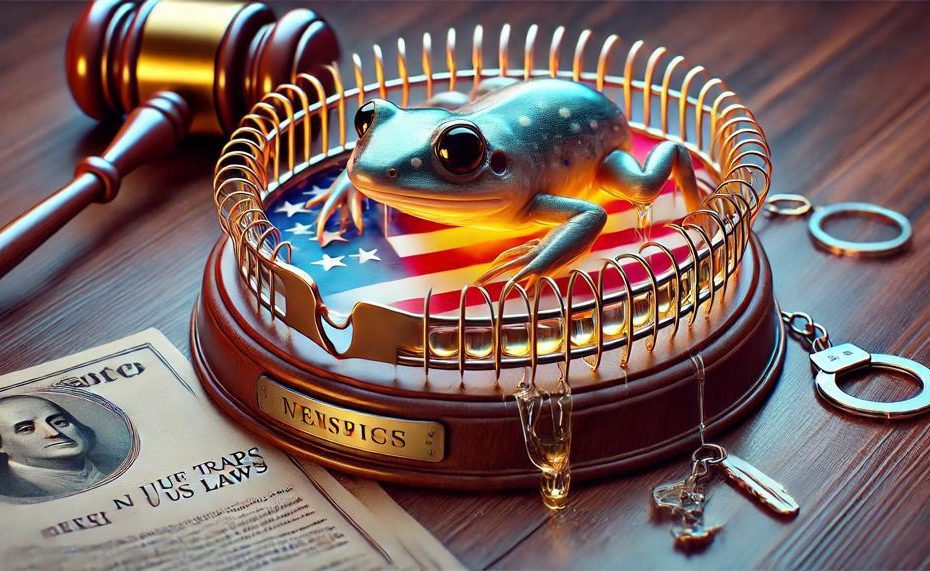Yes, glue traps are legal in the US. However, their legality varies significantly from state to state, with some states imposing bans or restrictions due to concerns over animal cruelty and safety.
Glue traps, often used for rodent and pest control, have sparked considerable debate. Animal rights organizations criticize them for being inhumane, as they can cause prolonged suffering to captured animals. Additionally, these traps pose risks of capturing non-target species, including pets and wildlife. Federal regulations, such as those under the Animal Welfare Act and EPA guidelines, also influence their use to ensure safety for both humans and animals. Many cities and municipalities have their own rules, making it essential to check local regulations before using glue traps.
Key Takeaways:
- Legal Status: Glue traps are legal but heavily regulated, with varying state laws.
- Controversy: Considerable opposition due to animal cruelty concerns.
- Federal Oversight: The EPA and Animal Welfare Act set safety guidelines.
- Local Bans: Many cities and municipalities impose their own restrictions.
- Alternatives: Safer and more humane pest control methods are available.
Table of Contents
- 1 Are Glue Traps Legal In The Us?
- 2 State Regulations on Glue Trap Usage
- 3 Federal Laws and Regulations for Glue Traps
- 4 Opposition to Glue Traps from Animal Rights Organizations
- 5 Health and Safety Concerns with Glue Traps
- 6 Alternatives to Glue Traps for Pest Control
- 7 Advantages and Disadvantages of Using Glue Traps
- 8 Conclusion
Are Glue Traps Legal In The Us?
The legality of glue traps in the United States is multifaceted, varying significantly from state to state and even within municipalities. Here is an overview of the current laws and regulations:
| Jurisdiction | Status | Details |
| Federal | Regulated | The Animal Welfare Act does not explicitly mention glue traps, but the U.S. Environmental Protection Agency (EPA) regulates them as pesticides to ensure safety. |
| California | Restricted | Some cities like San Francisco have banned glue traps entirely due to humane concerns and potential health hazards. |
| New York | Restricted | While the state allows their use, several municipalities impose restrictions to minimize harm to non-target species. |
| Massachusetts | Banned | Complete ban in certain municipalities and heavy restrictions elsewhere, driven by animal welfare advocacy. |
| Texas | Allowed | No specific statewide restrictions, but local regulations may apply. |
| Oregon | Restricted | Municipalities like Portland have strict regulations limiting their use. |
State Regulations on Glue Trap Usage
The regulations on glue traps vary significantly across the United States, reflecting a patchwork of laws influenced by animal welfare concerns and pest control needs. Here’s a detailed overview of the current state regulations on the usage of glue traps:

| State | Regulation | Details |
| California | Ban | Prohibits the importation, manufacture, sale, distribution, and use of glue traps. |
| New York | Restricted | While glue traps are widely used, there is significant advocacy for bans due to animal cruelty concerns. |
| Connecticut | Ban | Prohibits the use of glue traps for animal control due to cruelty considerations. |
| Illinois | Restricted | Allows use but with strict guidelines to minimize animal suffering. |
| Massachusetts | Ban | Prohibits the use of glue traps to protect wildlife from inhumane trapping. |
| Oregon | Ban | Prohibits the sale and use of glue traps, focusing on humane pest control methods. |
In many states without explicit bans, there are stringent guidelines ensuring that if glue traps are used, they must be checked frequently to prevent prolonged suffering of trapped animals. These regulations aim to balance effective pest control with humane treatment considerations.
Federal Laws and Regulations for Glue Traps
Federal laws and regulations surrounding the use of glue traps in the United States are not comprehensive. Here’s a detailed look at the key points:
Animal Welfare Act
The federal Animal Welfare Act emphasizes the humane treatment of animals but does not explicitly address glue traps.
This law primarily focuses on the welfare of animals in research, exhibition, and transport but leaves out specific guidelines for pest control methods like glue traps.
Environmental Protection Agency (EPA)
The EPA regulates glue traps classified as pesticides to ensure they are safe for humans, animals, and the environment.
Products must comply with the Federal Insecticide, Fungicide, and Rodenticide Act (FIFRA), which mandates proper labeling and usage instructions to prevent harm.
Inconsistent Enforcement
Enforcement of laws and regulations regarding glue trap usage can vary significantly across different jurisdictions.
Advocacy groups like PETA push for more consistent and humane regulations, urging for the adoption of alternative pest control methods.
Local Bans and Restrictions
Some states and municipalities have imposed their own bans or restrictions on glue traps due to ethical concerns and potential health hazards.
Local regulations can vary widely, with some areas opting for outright bans and others implementing strict usage guidelines.
Opposition to Glue Traps from Animal Rights Organizations
The primary concerns of animal rights organizations regarding the use of glue traps centre on the inhumane treatment and prolonged suffering of trapped animals. These traps cause immense distress and pain as animals become stuck, often leading to severe injuries, dehydration, starvation, or self-mutilation in their desperate attempts to escape.
The indiscriminate nature of glue traps also poses a significant threat to non-target species, including pets and wildlife, which can become unintended victims.
Concerns and Opposition Tactics:
| Concern | Description | Opposition Tactics |
| Inhumane Treatment | Animals caught in glue traps suffer immensely, often enduring prolonged distress and pain before dying from starvation or dehydration. | Conducting undercover investigations and releasing footage to highlight the cruelty of glue traps. |
| Lack of Selectivity | Glue traps do not differentiate between target pests and non-target species, resulting in the unintentional capture and harm of pets and wildlife. | Advocating for legislative changes and supporting bans or restrictions in various jurisdictions. |
| Ethical Concerns | Animal rights groups argue that causing unnecessary suffering to any animal is ethically unacceptable. | Campaigning through social media, public awareness initiatives, and partnering with retailers to discourage the sale of glue traps. |
| Availability | Despite ethical concerns, glue traps are still widely available and used, which perpetuates the cycle of cruelty. | Lobbying for tighter regulations and promoting humane alternatives for pest control. |
Legislative Efforts:
Animal rights organizations work tirelessly to influence legislation by:
- Lobbying for bans and restrictions: They push for local and state governments to prohibit the use of glue traps, as seen in California.
- Promoting humane alternatives: Advocating for pest control methods that are effective yet cause minimal harm to animals, such as snap traps or electronic traps.
- Raising Public Awareness: Through campaigns, these organizations educate the public about the cruelty associated with glue traps and encourage the use of humane alternatives.
For more detailed information on the ethical issues surrounding glue traps, you can visit the Glue Trap Wikipedia Page.
In essence, animal rights organizations are steadfast in their opposition to glue traps due to the severe and unnecessary suffering they inflict.
Health and Safety Concerns with Glue Traps
The potential health and safety concerns associated with using glue traps are numerous and significant.
- Disease Transmission: Mice caught in glue traps can carry and transmit diseases such as hantavirus, salmonella, and leptospirosis. As the mice struggle to free themselves, they can excrete urine and faeces, which may contaminate the surrounding area and pose a health risk to humans.
- Inhumane Treatment: Glue traps cause prolonged suffering for trapped animals. The trapped mice often endure severe stress and physical trauma as they struggle to escape, leading to dehydration, starvation, or self-inflicted injuries. This aspect raises ethical concerns and questions about the humane treatment of animals.
- Non-Target Animals: Glue traps are indiscriminate, capturing not only mice but also other small animals like birds, lizards, and even pets. These unintended captures can cause unnecessary suffering and death to non-target wildlife.
- Risks to Children and Pets: Glue traps can pose a danger to children and household pets. Curious pets and children can accidentally come into contact with the adhesive, leading to skin irritation, fur entanglement, or even ingestion, which may require medical attention.
- Environmental Impact: Disposal of glue traps contributes to landfill waste and can pose a risk to wildlife scavenging in landfills. The adhesive substances and trapped animals can harm animals that come into contact with disposed traps.
- Legal and Ethical Considerations: In many regions, the use of glue traps is regulated or banned due to their inhumane nature. Improper use and disposal can lead to legal repercussions and ethical dilemmas for individuals and businesses.
- Handling and Disposal: Proper handling and disposal of glue traps is crucial to minimize health risks and environmental impact. Incorrect disposal can lead to contamination and continued suffering for the trapped animals.
Alternatives to Glue Traps for Pest Control
There are several humane and effective alternatives to using glue traps for pest control. These methods are kinder to animals and safer for your household. Here are some of the best options:
| Type | Description | Advantages |
| Snap Traps | Snap traps are traditional traps that quickly kill rodents by snapping a metal bar down on their necks. | Quick death, reusable, widely available, cost-effective. |
| Live Traps | Live traps capture rodents without harming them, allowing for their release far from your home. | Humane, reusable, prevents death, safe for pets and children. |
| Electric Traps | Electric traps deliver a lethal shock to rodents, killing them instantly. | Quick death, reusable, hygienic, effective. |
| Sealing Entry Points | Identify and seal potential entry points to prevent rodents from entering your home. | Long-term solution, no harm to animals, cost-effective. |
| Clean Environment | Maintain cleanliness to avoid attracting pests. Store food properly and dispose of waste regularly. | Prevents infestations, no harm to animals, improves overall hygiene. |
Advantages and Disadvantages of Using Glue Traps
Glue traps, also known as sticky traps, are a common method for controlling mice in the United States. These traps consist of cardboard or plastic trays coated with a sticky adhesive designed to ensnare mice upon contact. Here’s a detailed look at the pros and cons of using glue traps:
| Advantages | Details |
| Easy to Use | Glue traps require no setting or baiting, making them straightforward to deploy. |
| Multiple Captures | A single trap can catch multiple mice, depending on the size of the trap and infestation. |
| No Injury to Humans or Pets | Unlike snap traps, glue traps pose no risk of injury to fingers or paws, making them safer in households with children and pets. |
| Versatile Placement | They can be placed in small, hard-to-reach areas where mice are likely to travel, such as behind appliances or in corners. |
Despite these advantages, glue traps come with significant drawbacks:
| Disadvantages | Details |
| Inhumane | Mice caught in glue traps often suffer for hours or days before dying from stress, dehydration, or starvation, making this a cruel method of pest control. |
| Difficult Release | If you wish to release a trapped mouse, doing so without injury is challenging due to the strong adhesive. |
| Ineffectiveness | Some mice may escape the traps or avoid them altogether, reducing their overall effectiveness in pest control. |
For those concerned with humane pest control, it is worth exploring alternatives such as snap traps, live traps, or electric traps. Sealing entry points and maintaining cleanliness can also help prevent infestations without resorting to glue traps.
Conclusion
The legality of glue traps in the United States presents a complex landscape shaped by federal guidelines and varying state and local regulations. While glue traps remain legal nationwide, their use is subject to significant scrutiny and regulation due to concerns over animal cruelty and safety.
Animal rights organizations have long criticized glue traps for their inhumane nature, highlighting the prolonged suffering they inflict on captured animals. These traps not only cause immense distress but also pose risks to non-target species, including pets and wildlife. Consequently, several states and municipalities have enacted bans or restrictions to mitigate these concerns. For instance, cities like San Francisco and Portland have implemented strict regulations or outright bans, while other states allow their use with certain limitations.
Federally, the Environmental Protection Agency (EPA) regulates glue traps as pesticides, ensuring they meet safety standards. However, the Animal Welfare Act, which emphasizes humane treatment, does not specifically address glue traps, leaving much of the regulatory burden to state and local authorities.
Given the controversy surrounding glue traps, many advocate for more humane alternatives, such as snap traps, live traps, and integrated pest management techniques. These methods aim to control pests effectively while minimizing animal suffering. If glue traps must be used, it is crucial to follow regulations diligently, check traps frequently, and handle any trapped animals with care to alleviate unnecessary suffering.






